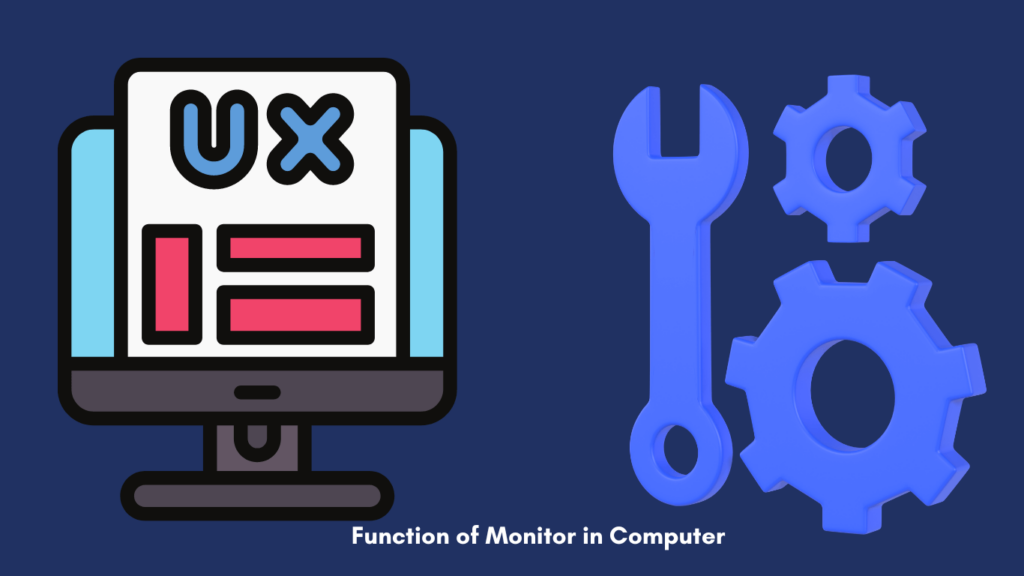Function of monitor in computer : In this article, I will take you on a journey to explore the various aspects of computer monitors, from their evolution to their advanced features. A computer monitor is not just a display screen; it plays a crucial role in our daily computing activities. So, let’s dive in and unlock the power of this essential device.

The Basic Functions of a Computer Monitor
The primary function of a computer monitor is to display visual information generated by a computer’s graphics card. It serves as the interface between the user and the computer, allowing us to interact with the digital world. A monitor receives signals from the computer and converts them into images that we can perceive.
One of the essential aspects of a monitor is its ability to provide a clear and sharp display. The quality of the monitor’s panel and its resolution play a significant role in determining the clarity of the images. Additionally, a monitor should have a high refresh rate to reduce motion blur, especially during fast-paced activities such as gaming or watching videos.
Another crucial function of a computer monitor is its ability to adjust various display settings. These settings include brightness, contrast, color temperature, and gamma. By fine-tuning these settings, users can customize their viewing experience to suit their preferences and the specific requirements of their tasks.
Advanced functions and features of computer monitors
In addition to their basic functions, computer monitors offer a range of advanced features that enhance productivity and convenience. These features include:
Ergonomic adjustments:
Many monitors can be adjusted for height, tilt, and swivel, allowing users to find a comfortable viewing position and reduce strain on their neck and eyes.
Built-in speakers:
Some monitors come with built-in speakers, eliminating the need for external speakers and cluttering the workspace.
USB Hubs:
Monitors with USB hubs provide additional USB ports, making it easier to connect peripherals such as keyboards, mice, and external hard drives.
Multiple Inputs:
Most modern monitors offer multiple input options, such as HDMI, Display Port, and VGA, allowing users to connect different devices simultaneously.
Display technologies used in computer monitors
Over the years, several display technologies have been used in computer monitors. Each technology has its own advantages and disadvantages, catering to different needs and preferences.
LCD (Liquid Crystal Display)
LCD (Liquid Crystal Display) monitors are one of the most common types available today. They use a layer of liquid crystals to control the passage of light, resulting in vibrant and accurate colors. LCD monitors are energy-efficient and offer a wide range of sizes and resolutions, making them suitable for various applications.
LED (Light-Emitting Diode)
LED (Light-Emitting Diode) monitors are a variation of LCD monitors that use LED backlighting instead of traditional fluorescent tubes. LED monitors offer better contrast, lower power consumption, and a thinner profile compared to LCD monitors.
OLED (Organic Light-Emitting Diode)
OLED (Organic Light-Emitting Diode) monitors are known for their exceptional image quality and deep blacks. Unlike LCD and LED monitors, OLED displays do not require a backlight, as each pixel emits its own light. This technology allows for more accurate color reproduction and higher contrast ratios.
Understanding screen resolution and aspect ratio
Screen resolution and aspect ratio are crucial factors to consider when choosing a computer monitor. Screen resolution refers to the number of pixels a monitor can display horizontally and vertically. Higher resolutions result in sharper images and more screen real estate for multitasking.
Aspect ratio, on the other hand, is the ratio of the width to the height of the display. The most common aspect ratio for computer monitors is 16:9, which is suitable for most tasks. However, ultrawide monitors with a 21:9 aspect ratio are becoming increasingly popular, offering an immersive viewing experience.
Choosing the right monitor for your needs
When selecting a computer monitor, it is essential to consider your specific needs and preferences. Here are some factors to keep in mind:
- Intended use: Determine the primary purpose of the monitor, whether it’s gaming, professional work, or multimedia consumption.
- Screen size: Consider the available desk space and the distance at which the monitor will be viewed. Larger screens offer more immersive experiences, but they may require more desk space.
- Resolution: Choose a resolution that suits your requirements. Higher resolutions are ideal for tasks that involve detailed work or multimedia consumption.
- Connectivity: Ensure that the monitor has the necessary ports to connect your devices. Consider future compatibility as well.
Maintaining and optimizing your computer monitor
To ensure the longevity and optimal performance of your computer monitor, it is crucial to follow some maintenance practices:
- Cleaning: Regularly clean the monitor’s screen using a microfiber cloth and a mild cleaning solution. Avoid using harsh chemicals or abrasive materials that may damage the screen.
- Power management: Adjust the power management settings on your computer to reduce the monitor’s energy consumption when not in use.
- Screen savers: Use screen savers or enable the monitor’s sleep mode to prevent static images from causing burn-in.
- Updating drivers: Periodically check for driver updates for your monitor to ensure compatibility and access to the latest features and optimizations.
Conclusion : Function of Monitor in Computer
In conclusion, computer monitors are not merely display screens; they are powerful devices that enable us to interact with the digital world. From their humble beginnings to the latest advancements, monitors have evolved significantly, offering an array of functions and features. By understanding the different types, technologies, and factors to consider, you can choose a monitor that meets your specific needs.
Remember to maintain and optimize your monitor to ensure its longevity and optimal performance. Now, armed with this knowledge, you can unlock the full potential of your computer monitor and enhance your computing experience.
